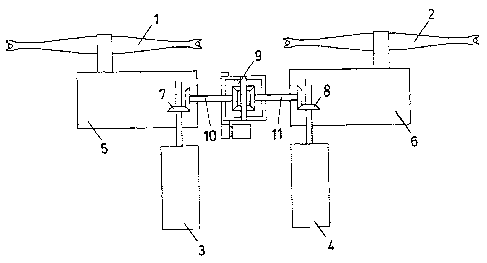Une partie des informations de ce site Web a été fournie par des sources externes. Le gouvernement du Canada n'assume aucune responsabilité concernant la précision, l'actualité ou la fiabilité des informations fournies par les sources externes. Les utilisateurs qui désirent employer cette information devraient consulter directement la source des informations. Le contenu fourni par les sources externes n'est pas assujetti aux exigences sur les langues officielles, la protection des renseignements personnels et l'accessibilité.
L'apparition de différences dans le texte et l'image des Revendications et de l'Abrégé dépend du moment auquel le document est publié. Les textes des Revendications et de l'Abrégé sont affichés :
| (12) Demande de brevet: | (11) CA 2544282 |
|---|---|
| (54) Titre français: | SYSTEME MOBILE POUR INSTALLATIONS DE CABLES AERIENS COMPRENANT DEUX CABLES DE TRACTION |
| (54) Titre anglais: | MOVING SYSTEM FOR A CABLEWAY PLANT COMPRISING TWO HAULING CABLES |
| Statut: | Réputée abandonnée et au-delà du délai pour le rétablissement - en attente de la réponse à l’avis de communication rejetée |
| (51) Classification internationale des brevets (CIB): |
|
|---|---|
| (72) Inventeurs : |
|
| (73) Titulaires : |
|
| (71) Demandeurs : |
|
| (74) Agent: | MARKS & CLERK |
| (74) Co-agent: | |
| (45) Délivré: | |
| (22) Date de dépôt: | 2006-04-20 |
| (41) Mise à la disponibilité du public: | 2006-11-03 |
| Licence disponible: | S.O. |
| Cédé au domaine public: | S.O. |
| (25) Langue des documents déposés: | Anglais |
| Traité de coopération en matière de brevets (PCT): | Non |
|---|
| (30) Données de priorité de la demande: | ||||||
|---|---|---|---|---|---|---|
|
Simplified regulation and balancing system applicable
to cableway plants, of the continuous or to-and-fro
type, equipped with two hauling cables functioning in
parallel.
In a system according to the invention, the two cables
are moved by distinct pulleys with separate winches;
the kinematic chains of the two winches however are
connected to each other by a device which is
structurally similar to a car differential, whose outer
box is kept blocked during normal functioning. In this
way, the two winches are mechanically constrained and
can rotate only at the same speed.
By rotating the differential box with an external
system, a corresponding difference in the rotation rate
is actuated between the two motor shafts; the rotation
can take place, for example, with a small balancing
motor-reducer which activates a toothed crown integral
with the box.
Note : Les revendications sont présentées dans la langue officielle dans laquelle elles ont été soumises.
Note : Les descriptions sont présentées dans la langue officielle dans laquelle elles ont été soumises.

2024-08-01 : Dans le cadre de la transition vers les Brevets de nouvelle génération (BNG), la base de données sur les brevets canadiens (BDBC) contient désormais un Historique d'événement plus détaillé, qui reproduit le Journal des événements de notre nouvelle solution interne.
Veuillez noter que les événements débutant par « Inactive : » se réfèrent à des événements qui ne sont plus utilisés dans notre nouvelle solution interne.
Pour une meilleure compréhension de l'état de la demande ou brevet qui figure sur cette page, la rubrique Mise en garde , et les descriptions de Brevet , Historique d'événement , Taxes périodiques et Historique des paiements devraient être consultées.
| Description | Date |
|---|---|
| Demande non rétablie avant l'échéance | 2012-04-20 |
| Le délai pour l'annulation est expiré | 2012-04-20 |
| Inactive : Abandon.-RE+surtaxe impayées-Corr envoyée | 2011-04-20 |
| Réputée abandonnée - omission de répondre à un avis sur les taxes pour le maintien en état | 2011-04-20 |
| Demande publiée (accessible au public) | 2006-11-03 |
| Inactive : Page couverture publiée | 2006-11-02 |
| Inactive : CIB en 1re position | 2006-08-03 |
| Inactive : CIB attribuée | 2006-08-03 |
| Inactive : CIB attribuée | 2006-08-03 |
| Demande reçue - nationale ordinaire | 2006-05-29 |
| Lettre envoyée | 2006-05-29 |
| Inactive : Certificat de dépôt - Sans RE (Anglais) | 2006-05-29 |
| Date d'abandonnement | Raison | Date de rétablissement |
|---|---|---|
| 2011-04-20 |
Le dernier paiement a été reçu le 2010-03-22
Avis : Si le paiement en totalité n'a pas été reçu au plus tard à la date indiquée, une taxe supplémentaire peut être imposée, soit une des taxes suivantes :
Les taxes sur les brevets sont ajustées au 1er janvier de chaque année. Les montants ci-dessus sont les montants actuels s'ils sont reçus au plus tard le 31 décembre de l'année en cours.
Veuillez vous référer à la page web des
taxes sur les brevets
de l'OPIC pour voir tous les montants actuels des taxes.
| Type de taxes | Anniversaire | Échéance | Date payée |
|---|---|---|---|
| Enregistrement d'un document | 2006-04-20 | ||
| Taxe pour le dépôt - générale | 2006-04-20 | ||
| TM (demande, 2e anniv.) - générale | 02 | 2008-04-21 | 2008-03-17 |
| TM (demande, 3e anniv.) - générale | 03 | 2009-04-20 | 2009-03-26 |
| TM (demande, 4e anniv.) - générale | 04 | 2010-04-20 | 2010-03-22 |
Les titulaires actuels et antérieures au dossier sont affichés en ordre alphabétique.
| Titulaires actuels au dossier |
|---|
| HIGH TECHNOLOGY INVESTMENTS B.V. |
| Titulaires antérieures au dossier |
|---|
| FERRUCCIO LEVI |